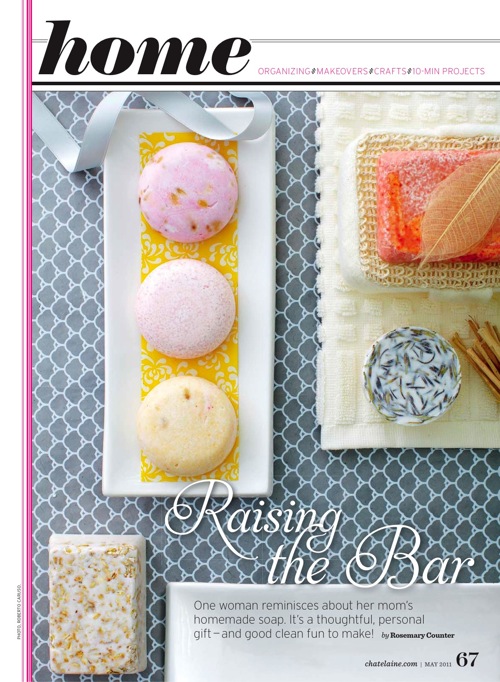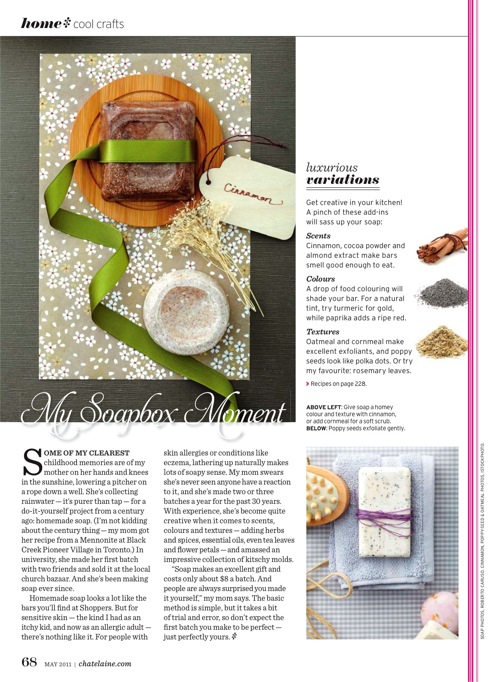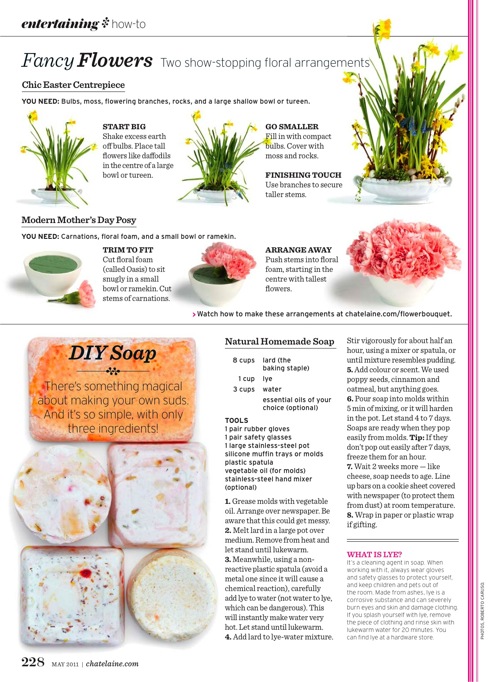Raising the Bar
One woman reminisces about her mom’s homemade soap. It’s a thoughtful, personal gift — and good clean fun to make
Some of my clearest childhood memories are of my mother on her hands and knees in the sunshine, lowering a pitcher on a rope down a well. She’s collecting rainwater — it’s purer than tap — for a do-it-yourself project from a century ago: homemade soap. (I’m not kidding about the century thing — my mom got her recipe from a Mennonite at Black Creek Pioneer Village in Toronto.) In university, she made her first batch with two friends and sold it at the local church bazaar. And she’s been making soap ever since.
Homemade soap looks a lot like the bars you’ll find at Shoppers. But for sensitive skin — the kind I had as an itchy kid, and now as an allergic adult — there’s nothing like it. For people with skin allergies or conditions like eczema, lathering up naturally makes lots of soapy sense. My mom swears she’s never seen anyone have a reaction to it, and she’s made two or three batches a year for the past 30 years. With experience, she’s become quite creative when it comes to scents, colours and textures — adding herbs and spices, essential oils, even tea leaves and flower petals — and amassed an impressive collection of kitschy molds.
“Soap makes an excellent gift and costs only about $8 a batch. And people are always surprised you made it yourself,” my mom says. The basic method is simple, but it takes a bit of trial and error, so don’t expect the first batch you make to be perfect — just perfectly yours.
Recipe: Natural Homemade Soap
YOU WILL NEED
8 cups lard (the baking staple)
1 cup lye
3 cups water
essential oils of your choice (optional)
TOOLS
1 pair rubber gloves
1 pair safety glasses
1 large stainless-steel pot
silicone muffin trays or molds
plastic spatula
vegetable oil (for molds)
stainless-steel hand mixer (optional)
1. Grease molds with vegetable oil. Arrange over newspaper. Be aware that this could get messy.
2. Melt lard in a large pot over medium. Remove from heat and let stand until lukewarm.
3. Meanwhile, using a nonreactive plastic spatula (avoid a metal one since it will cause a chemical reaction), carefully add lye to water (not water to lye, which can be dangerous). This will instantly make water very hot. Let stand until lukewarm.
4. Add lard to lye-water mixture. Stir vigorously for about half an hour, using a mixer or spatula, or until mixture resembles pudding.
5. Add colour or scent. We used poppy seeds, cinnamon and oatmeal, but anything goes.
6. Pour soap into molds within 5 min of mixing, or it will harden in the pot. Let stand 4 to 7 days. Soaps are ready when they pop easily from molds. Tip: If they don’t pop out easily after 7 days, freeze them for an hour.
7. Wait 2 weeks more — like cheese, soap needs to age. Line up bars on a cookie sheet covered with newspaper (to protect them from dust) at room temperature.
8. Wrap in paper or plastic wrap if gifting.


